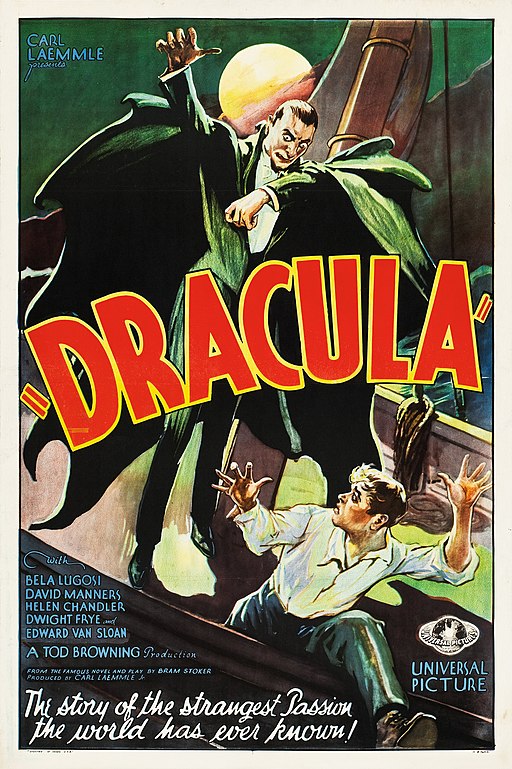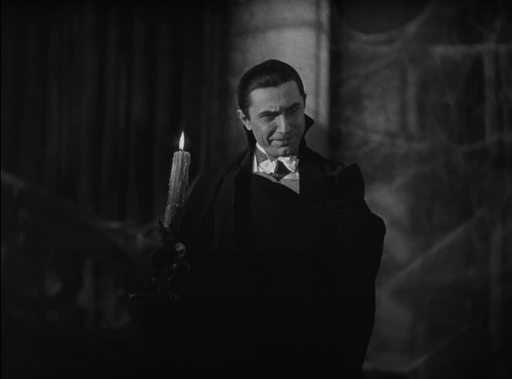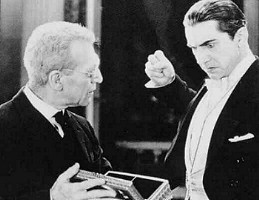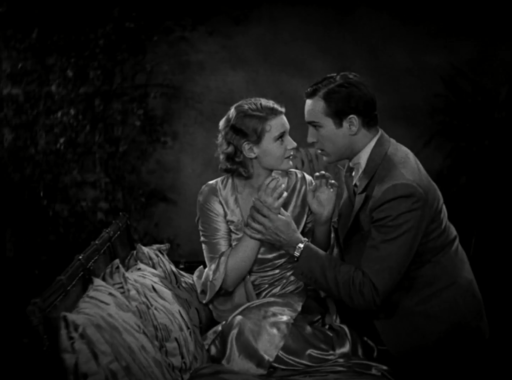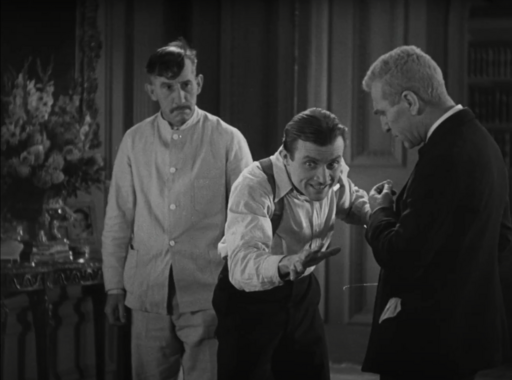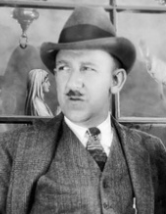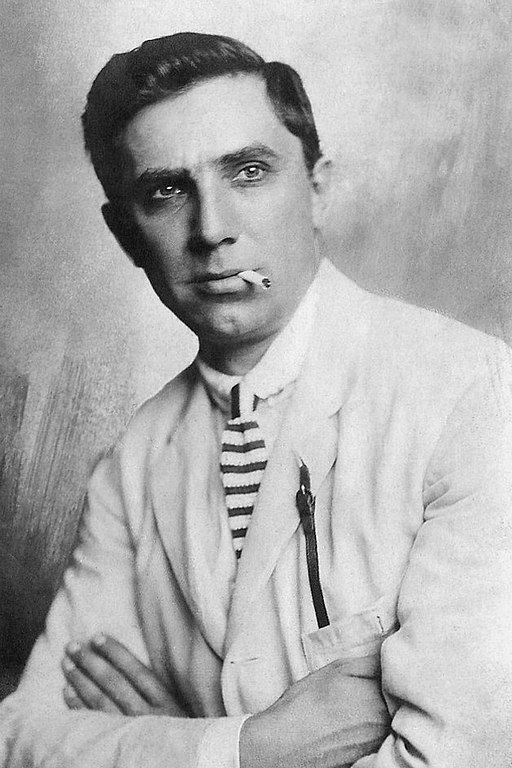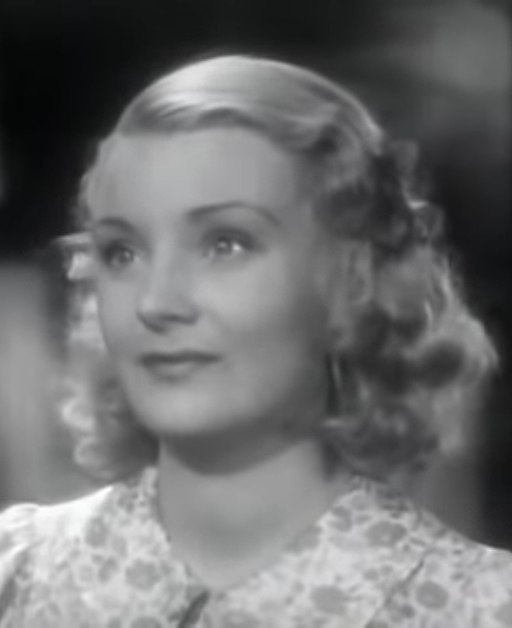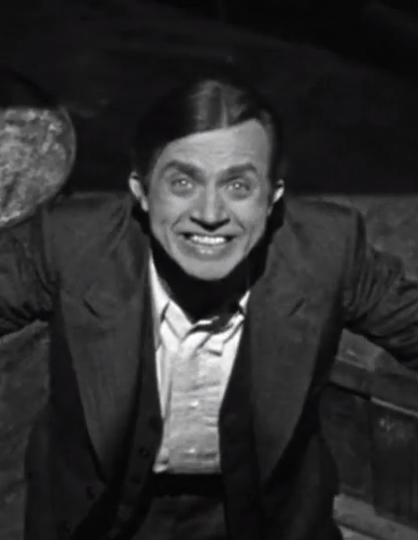Dracula - 1931
back| Released by | Universal Pictures |
| Director | Tod Browning |
| Producer | Tod Browning, Carl Laemmle Jr. |
| Script | The screenplay was written by Garrett Fort, based on the stage play by Hamilton Deane and John L. Balderston, which in turn was loosely based on the novel Dracula by Bram Stoker |
| Cinematography | Karl Freund |
| Music by | Originally, the film featured no music score except for the opening credits and a scene featuring a performance of |
| Running time | 75 minutes |
| Film budget | $ 340,000 |
| Box office sales | $ 700,000 |
| Main cast | Bela Lugosi - Helen Chandler - David Manners - Dwight Frye - Edward Van Sloan |
Dracula
The Mother of all Horror Movies
"Dracula" (1931), directed by Tod Browning and starring Bela Lugosi, is a landmark horror film that introduced audiences to the iconic character of Count Dracula, a Transylvanian vampire who relocates to England to spread his curse. Lugosi's portrayal set the standard for vampire characters with his charismatic and menacing performance.
The film's atmospheric tension, gothic visuals, and innovative use of sound and silence revolutionized the horror genre, cementing its place in cinematic history.
Related
Dracula – 1931
"Dracula" (1931), directed by Tod Browning, is a landmark horror film and a seminal work in the portrayal of vampires in cinema. The film is an adaptation of Bram Stoker's 1897 novel "Dracula," though it is more directly based on the 1924 stage play by Hamilton Deane and John L. Balderston. Bela Lugosi's performance as Count Dracula is iconic, setting the standard for vampire portrayals for decades.
Summary
The film opens with Renfield (Dwight Frye), a British solicitor, traveling to Transylvania to finalize a real estate transaction with Count Dracula, who wishes to purchase Carfax Abbey in England. Upon arrival at Dracula's castle, Renfield is mesmerized by the Count's commanding presence and falls under his thrall. Dracula, revealed to be a vampire, embarks to England on a ship, the Vesta, with boxes of Transylvanian soil, which he needs to sustain his power. During the voyage, Dracula preys on the crew, leaving Renfield as the sole survivor, driven to madness.
Once in England, Dracula infiltrates London society and sets his sights on Mina (Helen Chandler), the daughter of Dr. Seward (Herbert Bunston), who runs the sanatorium next to Carfax Abbey. Mina's friend, Lucy (Frances Dade), becomes Dracula's first victim, leading to an investigation by Dr. Seward, Mina's fiancé John Harker (David Manners), and the wise Professor Van Helsing (Edward Van Sloan). Van Helsing soon deduces Dracula's true nature.
As Dracula continues to prey on Mina, Van Helsing and Harker devise a plan to confront and defeat the vampire. The climax of the film sees them tracking Dracula to Carfax Abbey, where they find him resting in his coffin. In a tense and dramatic confrontation, they drive a stake through his heart, freeing Dracula's victims from his influence and ending his reign of terror.
Analysis
"Tod Browning's "Dracula" is a masterclass in atmosphere and suspense, utilizing shadows and sound to create a sense of dread. The film's lack of a musical score for much of its duration (as originally released) adds to the eerie silence of Dracula's world, punctuated only by dialogue, sound effects, and Lugosi's captivating voice.
Bela Lugosi's portrayal of Dracula is both charming and menacing, a dichotomy that has defined the character's legacy. Lugosi's performance, combined with Karl Freund's moody and expressive cinematography, creates a timeless villain who is both a predator and a gentleman. The film's gothic visual style has influenced not only the horror genre but also the visual language of cinema as a whole.
The film also explores themes of science versus superstition, with Van Helsing representing the voice of reason and knowledge in the face of an incomprehensible evil. The struggle between Dracula and Van Helsing is not just physical but ideological, highlighting the tension between modernity and ancient curses.
Despite its age, "Dracula" (1931) remains a powerful and influential film. Its impact on the portrayal of vampires and the horror genre is immeasurable, setting a template for countless adaptations and interpretations. The film's success also cemented Universal Pictures as a major player in the early horror film industry, leading to the creation of an entire universe of monster films.
In conclusion, "Dracula" is not just a horror film but a piece of cinematic history, illustrating the power of performance, atmosphere, and storytelling. It remains a compelling watch, both as a standalone film and as a critical piece of the vampire mythos in popular culture.
Classic Trailer of Dracula 1931:
Cast of Dracula:
- Bela Lugosi as Count Dracula
- Helen Chandler as Mina Harker
- David Manners as John Harker
- Dwight Frye as Renfield
- Edward Van Sloan as Professor Van Helsing
- Herbert Bunston as Dr. Jack Seward
- Frances Dade as Lucy Weston
- Joan Standing as Maid
- Charles K. Gerrard as Martin
Analysis of the Direction of Tod Browning:
Tod Browning's direction of "Dracula" (1931) stands as a pivotal moment in cinematic history, especially within the horror genre. Browning, who had already established himself as a director with a knack for the macabre and the unusual, brought a unique vision to the adaptation of Bram Stoker's novel. His direction in "Dracula" is characterized by several key elements that not only defined the aesthetic and thematic approach of early horror cinema but also left a lasting impact on the genre.
Atmospheric Tension
One of the most notable aspects of Browning's direction is the creation of atmospheric tension. Through the use of lighting, shadow play, and set design, Browning crafts a gothic ambiance that is both haunting and evocative. The stark contrast between light and dark, often achieved through the innovative cinematography of Karl Freund, contributes to a sense of unease and foreboding. This use of shadow not only enhances the horror elements but also adds a layer of psychological depth, reflecting the dual nature of characters and the hidden terrors of the mind.
Minimalist Approach
Browning's minimalist approach to dialogue and action further amplifies the film's eerie atmosphere. Instead of relying on extensive dialogue, Browning uses silence and sound effects to create tension and build suspense. This choice was partly influenced by the transition from silent to sound films, but it also demonstrates Browning's understanding that what is left unseen or unsaid can often be more terrifying than explicit horror. This approach allows the audience's imagination to fill in the gaps, making the experience of watching "Dracula" both personal and profound.
Characterization and Performance
Browning's direction of actors is another critical element of the film's success. He elicited a performance from Bela Lugosi that would become the definitive portrayal of Dracula, balancing charm and menace in equal measure. Lugosi's Dracula is both a sophisticated nobleman and a predatory monster, a duality that Browning and Lugosi skillfully convey. The director's work with the rest of the cast, particularly Dwight Frye as Renfield, also deserves mention. Frye's portrayal of madness and devotion to Dracula adds a layer of tragedy and horror to the film.
Pioneering Horror Themes
Under Browning's direction, "Dracula" explores themes of sexuality, power, and the unknown, pioneering motifs that would become staples of the horror genre. The film's subtle handling of these themes, combined with its visual style, sets it apart from contemporary horror films. Browning's ability to suggest rather than show, to imply horror lurking just beneath the surface of polite society, makes "Dracula" both a product of its time and a timeless classic.
Conclusion
Tod Browning's direction in "Dracula" is a masterclass in atmospheric and psychological horror. His innovative use of visual storytelling, combined with a restrained approach to narrative and performance, created a film that is not only a cornerstone of the horror genre but also a significant work in the history of cinema. Browning's ability to evoke fear and fascination, to make the audience feel the presence of the unseen, and to explore the darker aspects of human nature, ensures that "Dracula" remains a compelling and influential film, decades after its release.
Groundbreaking Performance of Bela Lugosi:
Bela Lugosi's performance as Count Dracula in the 1931 film "Dracula," directed by Tod Browning, is one of the most iconic and enduring portrayals in the annals of cinema. Lugosi's depiction of the Transylvanian vampire set the standard for all vampire characters that followed, blending an eerie otherworldliness with a magnetic charm that remains unmatched. Here's a closer look at the facets of Lugosi's performance that make it so compelling:
Charismatic Presence
Lugosi imbued Dracula with a hypnotic charisma, using his striking physical presence and deep, accented voice to draw both characters and audiences into his thrall. His performance is marked by a deliberate slowness of movement and speech, which conveys both the character's supernatural nature and his confidence. This measured demeanor contrasts sharply with the frenetic energy of his victims and adversaries, making Dracula seem all the more powerful and in control.
Mastery of the Gothic Tone
Lugosi's Dracula is the embodiment of the gothic horror aesthetic. With his piercing gaze, Lugosi conveys a sense of menace and foreboding, while his countenance and posture reflect the aristocratic bearing of the character. His ability to maintain this aura throughout the film, even in moments of silence, contributes significantly to the film's sustained atmosphere of dread. Lugosi's performance is a masterclass in using physicality and minimalism to evoke a complex character; his Dracula is not just a creature of darkness but a being of tragic elegance.
The Allure of the Vampire
A key aspect of Lugosi's performance is how he captures the allure of the vampire mythos. His Dracula is not merely a monster but a seductive and tragic figure, embodying themes of eternal life, forbidden desire, and the blurring of pleasure and danger. Lugosi's ability to suggest these themes through subtle gestures and looks adds a depth to the character that transcends the horror genre, making him a figure of fascination as much as fear.
Psychological Complexity
Lugosi's portrayal hints at the psychological complexity beneath Dracula's composed exterior. Through slight changes in expression and tone, Lugosi suggests Dracula's loneliness, his disdain for humanity, and his relentless pursuit of what he desires. This complexity makes Dracula a more nuanced antagonist, elevating the film from a simple horror story to a study of obsession, power, and the nature of evil.
Legacy and Influence
Bela Lugosi's performance has become the definitive portrayal of Dracula, influencing countless adaptations and interpretations of the character. The image of Dracula as a caped, elegant nobleman is largely drawn from Lugosi's portrayal, and his accent has become synonymous with the character. Lugosi's performance transcends the film itself, becoming an integral part of popular culture and the collective imagination.
Conclusion
Bela Lugosi's portrayal of Dracula is a testament to his skill as an actor and his understanding of the character. He delivered a performance that is both timeless and deeply rooted in the cultural and cinematic context of its time. Lugosi's Dracula is not just a horror icon but a complex character that continues to captivate and terrify audiences, demonstrating the power of performance to define and elevate a film.
Memorable Quotes from the Movie:
Dracula's Introduction to Renfield:
"I am Dracula."
This simple introduction, delivered by Lugosi with an eerie calm, sets the tone for the character's supernatural presence throughout the movie.
Dracula on the Atmosphere of His Home:
"Listen to them. Children of the night. What music they make."
This line, spoken as wolves howl in the background, underscores Dracula's connection to the darker aspects of the natural world and his delight in what terrifies ordinary humans.
Dracula's Hospitality:
"I bid you welcome."
Dracula says this to Renfield upon his arrival at the castle, showcasing his deceptive charm and the foreboding hospitality that awaits his guests.
On Superstition:
"The superstitions of today are the scientific facts of tomorrow."
This line, spoken by Professor Van Helsing, reflects the film's exploration of science versus the supernatural.
Van Helsing on Dracula's Powers:
"There are far worse things awaiting man than death."
A pivotal line that hints at the true horror of Dracula's curse, transcending the fear of death to touch upon the terror of eternal damnation and undeath.
Dracula's Seduction:
"To die, to be really dead, that must be glorious!"
Dracula's words to Mina, seducing her with the promise of eternal life and the escape from mortal woes, encapsulate his manipulative allure.
Dracula's Disdain for the Cross:
"Don't you know that I am much older than your Christianity?"
Though not a direct quote from the film, this sentiment captures the essence of Dracula's encounters with symbols of faith, reflecting his ancient and blasphemous nature against the backdrop of modern Christian beliefs.
Awards and Recognition:
- National Film Registry: In 2000, "Dracula" was selected for preservation in the United States National Film Registry by the Library of Congress as being "culturally, historically, or aesthetically significant." This recognition is one of the most prestigious honors a film can receive in the United States, underscoring its importance to American film history.
- Cultural Impact: While not an award, it's worth noting the film's profound influence on the portrayal of vampires in all forms of media. Bela Lugosi's portrayal of Dracula has become iconic, influencing countless adaptations and interpretations of the Dracula character and vampires in general.
- Legacy and Influence Recognitions: Various film critic associations and historical societies have acknowledged "Dracula" over the years for its pioneering role in establishing the horror film genre. These recognitions often come in the form of special screenings, retrospectives, and inclusion in lists of greatest films.
While "Dracula" may not have a list of awards and nominations in the traditional sense, its legacy and the reverence with which it is held by the film community and horror enthusiasts alike serve as a testament to its enduring value and impact.

